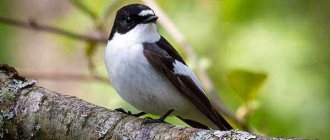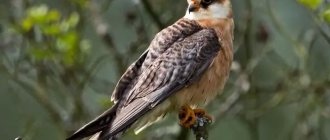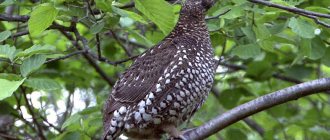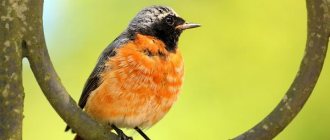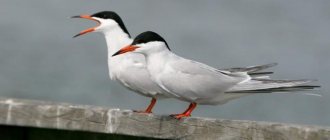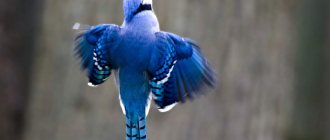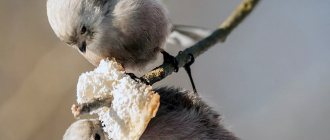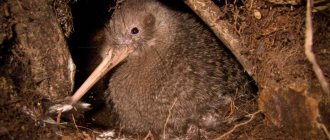Appearance
Sandpiper in profile on a wooden post
All waders differ in appearance from each other, especially in size. Thus, some species of sandpipers weigh 30-60 grams, while the mass of the largest curlews exceeds one kilogram. Waders are distinguished by the structure of their beak and legs, the length of their wings and tail. If grasshoppers have long and straight beaks, then sandpipers have short and thick beaks. The beak of the sandpiper serves as a tool for searching for food. The structure of the beak depends on the type of food that the sandpiper eats. Plovers have a short beak, thickened at the end, with which they collect food from the ground. Snipes have a thin, curved beak. With its help, the bird obtains food from the bottom of the reservoir.
White sandpiper foraging for food
— Advertising —
Stilt walkers have long slender legs, but snipes move on short legs. The legs of waders are four-toed, the hind finger is poorly developed. Colored snipes and webbed sandpipers have webs between their toes, comparable to aquatic birds. The tail of waders is short and wedge-shaped. The wings are narrow and long.
Kulik prepares to land
Waders have variable plumage colors. Most species of these birds are painted in bright, variegated colors. For example, the color scheme of the plumage of Turukhtans includes black, yellow, ocher, red and white; The feathers of crowned lapwings shimmer in the sun with emerald, purple and blue hues. Godwits, plovers, and plovers are more modestly plumed - the main part of the body is gray-brown with black and brown markings. Some species of waders have contrasting feather colors: the goldfinch has a black back dotted with light, thin transverse stripes; the feathers of stilts on the back are black, and on the neck and belly - white; in plovers, on the contrary, the belly is black, the neck is white, and the gray back is completely covered with white spots; The oystercatcher is similar in color to the common magpie. Waders are characterized by seasonal morphism of plumage: in the autumn-winter period, the color is dominated by gray and brown tones on the back, and the belly is white; in spring and summer, black and red feathers appear, and the underparts acquire rich cream shades.
Lively relative
This bird has a colorful relative that deserves attention. We are talking about turukhtan. Unlike the modest and inconspicuous waders, it has a spectacular appearance, a characteristic “collar” in the neck and a tuft on the head. In appearance and behavior, turukhtans are more reminiscent of fighting cocks. Their plumage shimmers in yellow, emerald, blue and red shades.
The structure of the bird's beak is similar to a rapier. The nature of the Turukhtan is aggressive, so fights between birds are a common occurrence. Conflicts arise mainly from the fact that the males did not divide the territory or the female. During the mating season, incidents between birds occur almost daily.
What do waders eat?
The sandpiper caught the fry.
Sandpipers feed mainly on invertebrate animals - aquatic and terrestrial insects, larvae, worms, crustaceans, mollusks and spiders. The lapwing's diet includes beetles and larvae. Plovers feed on insects, berries and seeds; Turukhtans eat crustaceans, lizards, grass seeds and grain crops. Large species of snails (great snail, herbal snail) feed on fish and frogs. In captivity, waders are fed with cereals, seeds and fruits of shrubs, grain and millet.
Nutrition
Sandpiper is a bird of water bodies. The diet of birds consists of aquatic and terrestrial invertebrate organisms - worms, crustaceans, mollusks, and various insects. Birds of prey eat mice and frogs, lizards; in the summer, locusts become a delicacy for birds, which they consume in large quantities.
Waterfowl fishing waders even dive for their prey. Some waders are vegetarians; their diet is based on grains, seeds, and berries. A special treat is blueberries.
Sandpiper - migratory bird or not
The sandpiper migrates
Sandpipers are migratory birds. Heat-loving birds are removed from their nesting sites with the arrival of the first frost. Shorebirds living in Russia fly away for the winter at the end of September - early October. European shorebirds migrate south in late October.
Waders fly very long distances for the winter. Some of them spend the winter 11 thousand kilometers from their home. Birds fly in pairs or flocks of 10-20 pairs. They fly at night and rest during the day.
A flock of waders of 18 individuals
The inhabitants of Siberia winter in Australia and New Zealand, the inhabitants of Alaska - in Argentina, European shorebirds - in South Africa and Madagascar.
Features of character and lifestyle
Photo: Sandpiper in flight
Sandpipers are socially organized birds that form entire colonies. Before flying to warmer climes, they gather in flocks that can number several thousand birds. Among them there are sedentary and nomadic birds, but the majority should still be classified as migratory. It all depends on the area where one or another species lives. Waders migrate over very impressive distances, soaring to a height of more than 6 km. Siberian birds flock to the Australian mainland and New Zealand for the winter. From Alaska, waders fly to Argentina. Waders winter in the vast expanses of Africa, Asia and India.
Interesting fact: During a migration, shorebirds are able to cover about 11 thousand kilometers without a single stop; they are not afraid of deserts, mountain ranges, or huge open water spaces.
There are waders that are active during the day, and there are birds that prefer twilight activity. Almost all waders are excellent runners, flyers and swimmers. Some species have diving talent. Waders have excellent eyesight and sensitive hearing. Bird lovers claim that waders are perfectly tamed, quickly adapt to a new environment, easily make contact with humans and happily eat home-cooked food.
Interesting fact: In the human environment, waders have earned respect due to the fact that they eat locusts that harm crops on a huge scale, and also like to snack on annoying blood-sucking mosquitoes.
Spreading
Area
Sandpiper in its natural habitat
Sandpipers are found throughout the world, with the exception of Antarctica. Sandpipers live in the Far North and in Alaska, along the coast of the Arctic Ocean, in Siberia and Chukotka. Snipes inhabit the subarctic and temperate regions of Eurasia, Iceland, and Ireland. Resident lapwings inhabit southern Europe, while migratory ones live in Scandinavia, the Moscow region and the Urals. Turukhtans spend the summer in the British Isles and Scandinavia. Curlews nest in North America and Chukotka. Different species of plovers live in America and Eurasia. Some plovers inhabit the coastal areas of the Amazon River in Latin America.
Sandpiper in the water
There are 75 species of waders in Russia. Plovers, lapwings and woodcocks have settled in the Far East, great and little godwits nest in Primorye, and Ussuri plovers nest in Altai. Representatives of the sandpiper family live in the Far North. The oystercatcher, sicklebill, avocet and many other bird families of waders have settled in the south of the country.
Habitats
Sandpiper cinematic shooting
Sandpipers are water birds. They nest in swampy lowlands in the midst of dense shrubby vegetation. Waders inhabit the coasts of rivers, lakes, and seas. Some species of waders live in cultivated fields, impenetrable tundras, steppe expanses, and mountain ranges. There are forest waders: woodcocks and dunnies nest exclusively in forest areas. For most waders, having water near their nesting sites is vital, but there are species of waders (for example, plovers, sandpipers, runners) that feel comfortable in desert and waterless areas.
Range, habitat
Waders prefer to settle in areas located in close proximity to bodies of water: along the shores of seas, rivers, and lakes. Among the representatives of this order there are also those that nest in dry and even desert places. There are waders that live in the forest.
On all continents except Antarctica you can meet waders: on the cold islands of the Arctic Ocean, in the deserts of Central Asia and in the high Pamir mountains.
In Russia, representatives of this largest order of birds can be found in all regions: from the southern borders to the Arctic. In the south of the Far East, herbivores, lapwings, carriers, plovers, and woodcocks nest. In Primorye there are sandflies and Asian snipe-tailed godwits, and mountain rivers are a favorite place for Ussuri plovers.
Japanese snipe and sea plover can only be found on the sea coast. In the Amur region there is a nesting area for greater and Okhotsk snipes, fifi, long-toed sandpipers and common snipe.
Mostly waders are migratory birds. During the migration period they rise to a height of more than 6000 meters. Most members of the order make long-distance flights: from polar Siberia to New Zealand and Australia, from Alaska to southern Argentina.
These birds can be called long-distance migrants - they fly non-stop up to 11,000 kilometers, covering enormous distances over water, deserts, and mountain ranges.
Lifestyle
A sandpiper walks through a swamp
. Sandpipers are active birds. They run well on the ground, fly quickly, swim and dive well. Birds live in colonies of 15-20 pairs. And during long-distance flights they gather in flocks of thousands.
Waders spend their time searching for food, lazily walking along the shallow water and digging the muddy bottom with their beaks. Sometimes they talk quietly to each other. Waders are peace-loving and friendly birds. In the shorebird family, fights and showdowns rarely occur.
Two waders together on a pond
However, while nursing the offspring, the birds become aggressive. Protecting the brood from animals that appear on their territory, waders show courage and ferocity. To drive away the uninvited guest, the birds gather in a group and attack him, sometimes pecking him to death.
Waders return from wintering in April, immediately after the snow melts. In the southern regions (Kazakhstan, Uzbekistan, Turkmenistan) they appear already in March, in Ukraine - in the last days of March, in the Moscow region - in April, in Yakutia - in mid-May. Immediately upon their return, the waders break into pairs and begin building a nest.
Reproduction
Male and female sandpiper
The males are the first to arrive from wintering grounds. Having become accustomed, they begin mating ritual flights that help attract females. The male's current flight occurs high in the sky. At this moment, the bird opens its wings and tail wide and makes heart-rending sounds. First, the sandpiper rises vertically, and then falls “stone down,” diving sharply above the surface of the earth. In flight, a female joins the male and mating occurs. When mating, birds call “tika-tika” or “taki-taki.” During the breeding season, waders live in isolation, but some, such as stilts and lapwings, prefer to exist in colonies and semi-colonies.
Waders are characterized by different types of mating behavior. In some species of plover and snipe, polyandry is common - the female makes 2-3 clutches from different males, and the males hatch the offspring. Sandpipers, plovers, sandpipers, godwits and curlews are monogamous, while ruffed sandpipers are polygamous birds (females incubate and care for their offspring on their own).
Sandpiper nest
The sandpiper sits in the nest - photo
The female is engaged in the construction of the nest. The sandpiper's home is a cup-shaped depression in the ground in the middle of dense shrubby vegetation. Some species of waders line the bottom of the nest with dry leaves, but usually waders lay eggs directly on the ground. Waders sometimes occupy empty tree nests of other birds.
Sandpiper eggs
Sandpiper eggs in the nest
At the end of April, the female sandpiper lays four pear-shaped eggs of a green hue with numerous brown spots of different sizes. The egg weight is 60-80 grams. Hatching of the offspring lasts 21 days. All this time, the female sits in the nest, and the male brings her food. The further north the bird's nesting region, the later its chicks appear. Thus, waders living in Europe lay eggs in April; inhabitants of the Moscow region reproduce in May; The mating season of waders from the Taimyr Peninsula occurs in mid-July.
Chicks
A sandpiper chick runs.
The chicks are born sighted and pubescent. On the second day of life they begin to walk, and after a week they leave the nest and get their own food. By one month, the chicks have permanent plumage. During the first summer, sandpiper cubs stay close to their parents. Adult birds teach chicks to hunt and hide in case of danger. When a wild animal appears, a female or male sandpiper grabs the baby by the neck and carefully carries it in flight to a safe distance. In the second year of life, young birds reach sexual maturity, they become adults and are ready to create their own family.
Curlew
These birds are brownish in color and have an elongated and downward curved beak. But the main thing that makes these representatives remarkable is that they are the largest of the genus of waders. The male spends mating games closer to his chosen one. On the ground, he raises his wings, moves his beak up and down, spreads his tail and folds it back. The established couples remain faithful to each other.
The male chooses the nest site. He, pressing himself to the ground, makes a hole with his feet. Next to the first hole, he digs out several more. The female chooses one she likes, and the waders line it with grass. Here the female lays one, but large, olive-colored egg with brown speckles. After sitting for several days, she brings the next egg, and then can replenish the clutch with a third and fourth. Both he and she take an active part in incubation. 26 to 28 days should pass before the first chick appears. Both parents also look after the babies. The chicks will be ready to fly at just over a month old. After this, several families with children unite into one flock and begin their migrations. They go to South Asia or Africa for the winter. Departure occurs early, around August, but some individuals may linger until September. Sometimes in Germany and England these waders decide to spend the winter in place.
There are five subspecies of curlew in our country, and there are eight in total.
Kinds
Sandpiper near the water
According to ornithologists, there are 214 species of sandpipers living in the wild. About half of the species of waders are listed in the International Red Book. The number of great snipes, sandpipers, curlews, steppe tigers, and lapwings is steadily decreasing. This is due to the fact that waders are hunted in many countries. In Russia, spring hunting of these birds is prohibited, but poachers shoot them all year round. 11 species are listed in the Red Book of Russia. The list includes avocets, yellow shanks, oystercatchers, mountain snipe and little curlew.
Shorebirds are grouped into 10 families, each of which includes several genera.
Snails (Tringa)
Sandpiper snails near the water
Appearance: birds the size of a thrush. Body weight 300-400 grams, length – 21-31 centimeters. Most subspecies are gray in color with white and black strokes.
Distribution: ulits include 10 species of birds living in Europe, Asia, and North America. Snails nest on the banks of reservoirs in the tundra, forests and steppes.
Features: while walking, birds seem to bow with their whole body.
Subspecies:
- dandy;
- herbalist;
- guarantor;
- large snail;
- Okhotsk snail;
- motley snail;
- hermit snail;
- blackie;
- fifi;
- American Ash Snail;
- ash snail;
- membranous snail.
Godwits (Limosa)
Godwit Sandpipers together on the water
Appearance: large wading birds with a long beak, thick at the end, curved downwards and long legs. They are similar in size to a pigeon. Body length is 20 centimeters, weight – 250-350 grams. The birds' winter plumage is smoky-brown, with reddish tints appearing in summer.
Distribution: godwit live in wetlands of Iceland, Norway, Sweden, Finland, Russia. Birds winter in Southern Europe, Africa, Southeast Asia and Australia.
Godwit on a vacant lot
Features: godwit live near water bodies in noisy flocks. With the reduction of marshes in recent years, the number of godwits has decreased. This species is close to vulnerable.
Subspecies:
- great godwit;
- Canadian godwit;
- Godwit;
- spotted godwit.
Curlews (Numenius)
Curlew on the grass
Appearance: Curlews are slender birds with a long beak curved downwards. Body weight – 900-1500 grams, length – up to 65 centimeters, wingspan – 90-100 centimeters. The plumage color is beige with brown and black splashes. The large and medium-sized curlews have a white loin.
Distribution: Curlews live in marshy areas in northern European countries. The highest concentration of birds in Russia is observed in Kyrgyzstan and on the eastern coast of Lake Baikal. Curlews winter in southern Asia and Australia.
Curlew walks in the water
Features: curlews swim well, their flight is sharp and diving. During winter migrations, birds gather in a large flock and form a wedge, which is not typical for waders.
Subspecies:
- great curlew;
- long-billed curlew;
- Far Eastern curlew;
- little curlew;
- average curlew;
- Tahitian curlew;
- slender-billed curlew;
- Eskimo curlew.
Sandpipers (Calidris)
A sandpiper walks through the swamp
Appearance: birds with a dense build, short legs and a short straight black beak. Body weight reaches 700 grams, length – 25-28 centimeters. The lower part of the body is smoky in color; the head, back, wings and tail are greenish-brown. During the mating season, red and red tones appear in the color.
Distribution: Sandpipers nest in arctic and subarctic climates. They are found on the coasts of the Arctic Ocean, in Eastern Siberia and the Far East. Dunlins inhabit the tundra of North America and Scotland; in addition, they nest in Sakhalin, the Kuril Islands, and Kamchatka. Sandpipers, Bering sandpipers, and white-tailed sandpipers live in Scandinavia and the Aleutian Islands.
Features: sandpipers lead a secretive, silent lifestyle. The bird's diet includes invertebrates that live on the surface of the water.
Common subspecies:
- large sandpiper;
- Icelandic Sandpiper;
- small sandpiper;
- sandpiper sparrow;
- baby sandpiper;
- dunlin;
- ruby-throated sandpiper;
- long-toed sandpiper;
- blower;
- gerbil;
- sandpiper;
- Canadian sandpiper;
- mudman;
- Stilt Sandpiper;
- shovel;
- redshank;
- sandpiper sparrow
Turukhtan (Philomachus pugnax)
Turukhtan sits on the ground
Appearance: Turukhtans have long legs and beak, slender body. The bird's weight is 800-120 grams, length - 55 centimeters. Turukhtans have variegated plumage, which contains green, yellow, blue, and red shades. Outside the mating season, the intensity of the feather color decreases. In spring, males develop a feather collar and ears.
Distribution: Turukhtans are migratory birds that nest in damp areas in northern Eurasia. They winter in Southern Europe, South Africa, Asia and Australia. During migration, birds stay in a flock. Bird colonies of thousands form in rest areas.
Feature: Turukhtans are known for their quarrelsome, aggressive character. Serious fights constantly occur between birds, ending in the death of the weaker participant.
Snipe (Gallinago)
Snipe is looking for food in the swamp
Appearance: thin birds with short legs, a long thick neck and a long straight beak. Body length up to 50 centimeters, weight – 800-1000 grams. The plumage of the belly and chest is white, the upper part is motley. There are two white stripes along the crown and sides of the back.
Distribution: snipes live in the northern latitudes of Eurasia, Iceland, North America, and Great Britain. The species is found sporadically in the Azores and Faroe Islands. Snipes winter in Southern Europe, Asia, and Africa.
Snipe sits by the river
Features: Snipes are characterized by mating - this is a rapid vertical flight to a height of up to 100 meters, and then a rapid fall down. During the current, the birds mate. During flight, the wings vibrate under pressure and produce a sound similar to the bleating of a ram.
Common subspecies:
- mountain snipe;
- wood snipe;
- great snipe;
- snipe;
- Garnish;
- hermit snipe;
- woodcock.
Plovers (Pluvialis)
Plover in profile - photo
Appearance: small birds with long green legs and a long brown beak. Smaller than a pigeon. Body weight is 500 grams, length – 35 centimeters. The plumage is black and white, with golden yellow and white spots on the black back.
Distribution: Migratory plovers nest in the tundra of Eurasia and North America. They fly to South America, Australia and New Zealand for the winter.
Photo of a plovers in a meadow
Features: during migrations, plovers cover distances of 11,000 kilometers. Their flight is fast and swift. Its speed reaches 70 kilometers per hour.
Common subspecies:
- American brown-winged plover;
- golden plover;
- Tules;
- brown-winged plover;
- Chrystal or Silly Plover;
- lapwing or pigtail.
Plovers (Charadrius)
Plover in the grass
Appearance: plovers are small birds similar to sparrows. Their body weight is 180-250 grams, length is 20 centimeters. During the mating season, the birds' plumage becomes covered in white, black, sand and reddish shades. The head is colored brighter than the body. There is a dark transverse stripe on the chest. The beak is yellow, black at the end.
Distribution: plovers are found in Europe (England, Norway, Sweden), the Canary and Azores Islands, North Africa (Algeria, Tunisia), Egypt. In Asia they nest in Korea, Japan, China, and Indonesia. Some species live in America. Northern varieties fly south for the winter.
Plover sat on the stones
Features: plovers do not know how to swim, so they look for food in the sand near water bodies, looking for food with the help of a short beak.
Subspecies:
- Maori plover;
- web-toed ruffed lizard;
- Ussuri plover;
- small plover;
- short-billed plover;
- sea plover.
- shepherd plover;
- mountain plover.
Avocet (Recurvirostra avosetta)
Avocet sits in the sand
Appearance: a large bird with black and white contrasting plumage and an upwardly curved beak. Body weight up to 500 grams, length – 50 centimeters. The legs are long and gray.
Distribution: birds live in Eurasia and Africa. In Russia they nest in the Ciscaucasia, southern Siberia and the Caspian region.
Features: Avocets are excellent runners. While moving, they stretch their necks and bend their heads to the ground, while spreading their wings wide and emitting low, hoarse sounds.
Oystercatcher (Haematopus ostralegus)
An oystercatcher flies over a pond
Appearance: a large bird with black and white plumage. The beak is medium-length and orange. Body length 40-47 centimeters, weight 420-820 grams, wingspan 80-86 centimeters.
Distribution: Oystercatchers live in Western Europe, central Eurasia, Kamchatka, China and western Korea.
Features: The oystercatcher is a member of a small family of waterbirds, Haematopodidae, that live exclusively on sea coasts.
Subspecies:
- New Zealand oystercatcher;
- Australian oystercatcher;
- piebald oystercatcher.
Interesting facts about waders
Oystercatcher near the water
- Many waders, such as snipe and woodcock, are hunted.
- Plovers can fly tirelessly for 11 thousand kilometers.
- The diet of some species of waders includes waste products.
- Waders benefit humans by eating harmful insects and their larvae in cultivated fields.
- The meat of waders is dry and stringy. To make the dish juicy and fatty, the meat is cooked for at least five hours.
- Kulich meat is dietary. 100 grams of product contains 130 kcal.
Enemies of shorebirds
The main enemy of waders is the golden eagle.
The life expectancy of waders is 15-20 years. Unfortunately, most birds do not live to be 5 years old, since waders have many natural enemies among birds of prey. Falcons, golden eagles, buzzards and kites hunt sandpipers, plovers, curlews and other representatives of the waders family. Birds of prey catch slow waders when they themselves hunt in the water. At this time, they become defenseless, as they are busy looking out for prey. When a predator approaches, waders try to swim away or run away, but, as a rule, the stronger opponent gains the upper hand.
Waders at home
Sandpiper sits on the hand
Sociable sandpipers become devoted pets for people. The sandpiper raised in captivity is not afraid of humans and gets used to domestic animals and local food. Birds adapt to their living conditions and diet. Unfortunately, domesticated waders do not reproduce well.
It is not advisable to keep waders in cages. These birds are quite active, so in a confined space they behave restlessly, hitting the bars. It is best to arrange a spacious enclosure for the sandpiper, which will have a nesting area, a feeder and a trough with water. The bird will feel comfortable if it is kept next to a natural body of water, in which it will independently search for food.
Sandpiper walks in the water
Domestic waders are fed worms, mealworms and zofobus. Sometimes bloodworms are added to the wet bread mash. Some amateur ornithologists switch wild birds to raw lean meat (or heart), cut into small thin slices.
Voice
The sandpiper sings.
The voices of sandpipers are varied. Each species of bird has its own way of communicating with its fellows. The voice of the dusky sandpiper is ringing and loud. The calling calls of the male consist of the monosyllabic word “pip”, which is repeated every 4-5 seconds. The songs of sandpiper sparrows are faster. They repeat “pew-pew-pew” over and over again. The chorus is slow, but the song speeds up with every second. At the end there is a peak ringing sound “Pyuyu”, then the bird subsides, and after a few seconds the song repeats again. The sounds made by oystercatchers are similar to the squeak of a chicken. The birds quickly, quickly pronounce the sound “pili-pili”. When birds sing in chorus, the sound becomes continuous and similar to the voices of a flock of seagulls. Black waders are characterized by a ringing squeak “eep-eep”.
Goldfinch snails rarely speak. During negotiations with brothers, they make two-syllable sounds “tu-viit-tu-viit”.
Two waders together on the water
Many waders become talkative while mating. Godwits, describing circles, monotonously repeat “vu-eetyyu-vu-eetyuyu” or quickly sing “tevvee-tevvee”. Singing speed and intonation may vary. If a male invites a female, he shouts “tevek-tevek” or “ve-te-te”. When danger is detected, it abruptly repeats “te-vve-te-vve” or “terevezhzhzh.” During the breeding season, you can hear the low voice of the snipe, which resembles the bleating of a ram. The repeated “bala-bala-bala-bala” has a different tempo: the song starts slowly, then speeds up every second and ends with a sharp “br.”
The singing of plovers is similar to the sounds of a flute. It is just as melodic, smoothly flowing from low to high tones. The syllables are usually open, ending in “ee” or “uu”. Sometimes the song is interrupted by an abrupt “pew-pew” signal, which sounds for 3-4 seconds, then the sounds begin to alternate: the drawn-out “pew-pew” gives way to a fast and high-pitched “pili-pili”.
The oystercatcher calls
Many waders are silent and vocalize only in times of danger or when mating. At this time, the birds make soft, hoarse “hiuu-hiuu” sounds. The woodcock's voice is not very harmonious. His voice is similar to the clucking of a chicken or grunting, like “khyr-khyr”. Snipes talk mainly at night. With the onset of darkness, solitary males emit sharp “tundra” calls. At the moment of takeoff, the snipe shouts “zhech”, on the ground this word is transformed into the overflowing sounds of “che-keche-ke”.
Garschnep
This is a very tiny Easter cake. Its weight is only 60 grams. But at the same time, many hunters do not allow the opportunity to catch it, because its meat is very tasty. But for ornithologists, the mating behavior of these little ones is of interest. You can hear the muffled sounds made by the spearfish in calm and cloudy weather. At the same time, it is impossible to catch where the singing is coming from, because the sandpiper swims high and moves very quickly. The sounds of birds playing mating games are reminiscent of stomping on compacted earth: “tap-tap-tap.”
